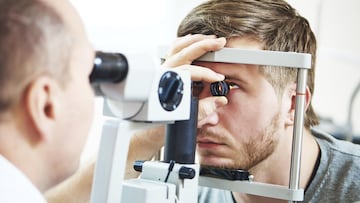Introducing the new smart wearable gear, Sci-Fi contact lenses of the future
Several companies are working on contact lenses that will be able to improve vision, treat diseases and even augment reality. Here’s a look at the new tech.

How would you like to be able pop in contact lenses to see in the dark, augment reality and record what you see or be warned that your blood sugar is getting too low? While it seems like the stuff out of science fiction, technological advancements have made it possible for companies to test the feasibility of these concepts and more by placing sensors and microLED displays the size of a grain of sand on to contact lenses.
“In the short term, it sounds like a futuristic idea,” Ana Belén Cisneros del Río, deputy dean of the College of Opticians-Optometrists in the Spanish region of Castilla y León, of the Mojo Vision project told El País. “But 20 years ago we couldn’t even imagine many of the technological advances that we have today.”
Also see:
Augmented reality contact lenses that correct your vision
Since 2015 the American startup Mojo Vision is just one company that has been refining various prototypes. One of those involves augmented reality lenses that would allow the wearer to consult a range of information as well as correct vision. Much like you can use your smartphone or watch to monitor your pace while running or guide you through an airport, the lenses would do the same without having to take your eyes away from what’s in front of you.
Mojo vision is not the only company with an ambitious vision for the future of this technology, Magic Leap is also working on AR contact lens technology. However, CEO Peggy Johnson doesn’t think they will be on the market anytime soon. There are efforts to install cameras in the lenses as well, like a project Samsung is working on, with the additional ability of projecting images into the user’s eye.
The Korean technology powerhouse has filed a patent for its wearable smart gear for the eyes. Sony has too, for its lenses that can record video. Other companies are seeking to improve the sight of the wearer by allowing them to zoom in and out simply with the blink of an eye, which would also power the gear. As well researches are developing lenses that would give people night vision, both of these last two would be useful for military applications.
The first wearing test for @MojoVisionInc smart contact lenses, to realize "a computer that can be seen by the eyes"#Wearables #IoT #AI #AR #MR @JolaBurnett @Hana_ElSayyed @CurieuxExplorer @anand_narang @debashis_dutta @Khulood_Almani @PawlowskiMario @mvollmer1 @labordeolivier pic.twitter.com/A8hMMgflxn
— Franco Ronconi 🇮🇹 (@FrRonconi) October 29, 2022
Health applications of the smart contact lenses
Healthcare technology has been garnering an ever growing level of investment, doubling year-on-year. Smart contact lenses could play an important role in the future of monitoring people’s health and even treating diseases.
“The presence of biomarkers in the tear fluid will lead to diagnostic contact lenses,” says Cisneros. “[These] will help detect and treat systemic and ocular diseases, such as diabetes, cancer and dry eye syndrome.”
She foresees the lenses being able to monitor eye pressure to detect hypertension or stroke and look for the onset of glaucoma. They could also be used by diabetics to measure blood glucose levels with efforts by some for the lenses to change color to alert about changes in the user’s blood sugar levels. They could even monitor how a patient is reacting to medication or responding to a surgical procedure.
Another use of the wearable smart eye-gear could be to deliver exact dosages of drugs to treat ailments. Cisneros thinks that “drug- delivering contact lenses could offer more precise dosage than traditional eye drops.” The lenses would have the added benefit of “increasing the time that a drug remains on the ocular surface and reducing side effects,” she said.
These smart contact lenses have embedded computer circuitry that allows you to focus at long distances and display data with simple eye movements pic.twitter.com/E7VlMd0hqd
— Vala Afshar (@ValaAfshar) October 25, 2022
Issues that smart contact lenses need to overcome
One of the handicaps of the smart lenses is the technology presently cannot detect multiple chemical components in real time. When that is made possible it “will make contact lenses more powerful as biomedical tools,” according to the authors of a review published in the journal Advanced Intelligent Systems.
Related stories
Another is that the components of the lenses cannot be opaque or made of brittle and rigid materials. The former could obstruct the user’s vision and the latter cause damage to the cornea or the eyelid cautions review published in the journal Advanced Materials Technologies.
Specialist in cornea, cataract and refractive surgery and medical director of the Institute of Ocular Microsurgery (IMO) Miranza Group in Madrid, Daniel Elies, told El País that he doesn’t think that smart contact lenses will be available to the average Joe or part of everyday life in the near future. This is especially down to the elevated cost of the technology. But in the distant future he sees it being feasible that people will be walking around with the wearable smart eye-gear loaded up with a camera or a range of sensors.


